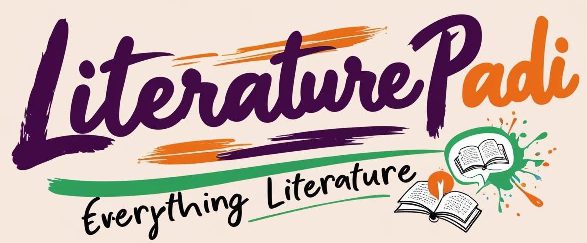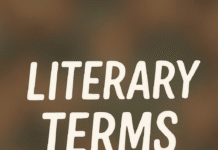📢 Follow our WhatsApp Channel for the latest literary updates!
Poetry is one of the core genres of literature, and understanding its unique characteristics is essential for both students and literary enthusiasts. What makes poetry stand out from other literary forms like prose fiction, drama, and non-fiction? The answer lies in the distinct elements of poetry. These elements serve as tools through which poets communicate experiences, emotions, and ideas, giving depth and resonance to their work.
What Are the Elements of Poetry?
The primary elements that distinguish poetry from other literary genres are:
- Imagery
- Rhythm
- Sound
- Diction
Let’s begin with the most vivid of them—imagery.
What Is Imagery in Poetry?
Imagery is the use of language that appeals to our five senses—sight, sound, smell, taste, and touch—to create mental pictures or evoke sensory experiences in the reader’s mind.
Put simply, imagery is the sensory content of a poem. It allows readers to see, hear, feel, smell, and taste what the poet is describing. This use of vivid, descriptive language helps to:
- Arouse specific emotions
- Add beauty and aesthetic appeal
- Convey abstract ideas in concrete terms
- Make life experiences more tangible
In other words, imagery helps the reader to visualise scenes, feel emotions, and connect deeply with a poem’s message. It bridges the gap between the intangible and the tangible. In Shakespeare’s words, it gives “to airy nothing a local habitation and a name.”
Imagery often relies on figurative language—similes, metaphors, personification, and onomatopoeia—to create its effects. These figures of speech are the tools through which poets intensify meaning and create lasting impressions in the reader’s mind.
Consider this example from George Herbert’s “Virtue”:
“Only a sweet and virtuous soul,
Like seasoned timber, never gives…”
The abstract idea of virtue is likened to seasoned timber, giving it a tactile, visual quality.
Types of Imagery in Poetry (With Examples)
Below are the six main types of imagery commonly used in poetry, each with examples from renowned poets:
1. Auditory Imagery – Sound
This appeals to our sense of hearing. Auditory imagery often employs onomatopoeia—words that mimic actual sounds (e.g., bang, murmur, hiss).
Examples:
- “It is drumming hard here… Droning with insistent ardour”
(J.P. Clark, “Night Rain”) - “The roof sizzles at the waking touch… like kettledrums”
(Niyi Osundare, “Raindrum”) - “Instruments of slaughter stutter out a message”
(J.P. Clark, “Benin Sacrifice”)
These lines make us “hear” the rain, drums, or gunfire, drawing us into the poet’s world.
2. Olfactory Imagery – Smell
This type evokes the sense of smell—sweet, foul, pungent, or fresh.
Examples:
- “The air was heavy with odours of diarrhoea…”
(Chinua Achebe, “A Mother in a Refugee Camp”) - “Stench of rancid breath of public hide-and-speak”
(Wole Soyinka, “Telephone Conversation”)
These smells contribute to a vivid depiction of discomfort, decay, or poverty.
3. Tactile Imagery – Touch
This evokes the sense of touch, including textures, temperature, or movement across the skin.
Examples:
- “Death lays his icy hand on kings”
(James Shirley, “The Glories of Our Blood and State”) - “Cold as the touch of steel in a harmattan night”
(Okinba Launko, “Separation”)
These descriptions make the emotional weight of death and loneliness palpable.
4. Gustatory Imagery – Taste
This imagery appeals to our sense of taste—sweet, sour, bitter, spicy.
Examples:
- “My husband’s tongue is bitter like the roots of the Lyono lily”
(Okot p’Bitek, “Song of Lawino”) - “Stop to feed itself at tanks”
(Emily Dickinson, “I Like to See It Lap the Miles”)
The poets use taste as metaphor to describe emotions or human behavior.
5. Visual Imagery – Sight
Visual imagery appeals to the sense of sight and is often the most common form of imagery in poetry.
Example:
- “Children with washed-out ribs and dried-up bottoms…”
(Chinua Achebe, “Beware Soul Brother”)
This image of malnourished children is both powerful and heartbreaking.
6. Kinaesthetic Imagery – Movement
Kinaesthetic imagery evokes the sense of movement or motion in a scene.
Examples:
- “Five miles meandering with a mazy motion…”
(S.T. Coleridge, “Kubla Khan”) - “Clouds come hurrying with the wind… like a madman chasing nothing”
(David Rubadiri, “An African Thunderstorm”)
Such lines help readers visualise rapid motion and instability.
Other Examples of Imagery
Visual imagery:
“The moon was a ghostly galleon tossed upon cloudy seas.” — The Highwayman by Alfred Noyes
Auditory imagery:
“I hear America singing, the varied carols I hear.”
— I Hear America Singing by Walt Whitman
Olfactory imagery:
“Her scent was cinnamon and clove, sharp and warm at once.”
In African poetry, imagery is often drawn from nature, oral tradition, folklore, and rural life. For example, in Okot p’Bitek’s Song of Lawino, the speaker uses vivid natural and cultural imagery to defend traditional African values against colonial influence:
“My husband’s tongue
Is bitter like the roots of the Lyono lily…”
What is Rhythm in Poetry?
Rhythm refers to the pattern of stressed and unstressed syllables in a line or stanza. It is the beat of poetry—the arrangement of sounds that creates a sense of movement. Just as a song has a tempo, a poem has rhythm. It is this rhythmic quality that gives poetry its melodic structure, enhances memorability, and helps reinforce meaning and emotion.
Poets use rhythm to:
- Evoke emotions such as excitement, tension, sadness, or calmness.
- Emphasise key ideas or themes through repetition and variation.
- Create musicality, often making poems more enjoyable to read or listen to aloud.
- Control the pace of the poem—either speeding it up or slowing it down.
Types of Rhythm in Poetry
Different rhythmic patterns are created using metrical feet, which are combinations of stressed and unstressed syllables. Common types of meter include:
- Iamb (unstressed-stressed): e.g., “The woods are lovely, dark and deep” – Robert Frost
- Trochee (stressed-unstressed): e.g., “Tyger Tyger, burning bright” – William Blake
- Anapest (unstressed-unstressed-stressed): e.g., “And the sound of a voice that is still” – Thomas Hood
- Dactyl (stressed-unstressed-unstressed): e.g., “Half a league, half a league” – Alfred Tennyson
Rhythm in African Poetry
In African poetry, rhythm often stems from oral traditions and drumming patterns. African poets like Okot p’Bitek and Niyi Osundare often rely on free verse or traditional rhythmic patterns rooted in indigenous chants and songs.
Rhythm, in this context, is not bound by classical meter but flows naturally from speech patterns, cultural cadence, and emotional expression.
Sound in Poetry
Sound devices in poetry enhance the musical quality of a poem and often work hand-in-hand with rhythm and imagery. These devices appeal to the sense of hearing and include tools such as alliteration, assonance, consonance, onomatopoeia, and rhyme.
Key Sound Devices in Poetry
- Alliteration – The repetition of initial consonant sounds.
Example: “Peter Piper picked a peck of pickled peppers.” - Assonance – The repetition of vowel sounds within words.
Example: “Hear the mellow wedding bells.” – Edgar Allan Poe - Consonance – The repetition of consonant sounds, typically at the end of words.
Example: “The lumpy, bumpy road.” - Onomatopoeia – Words that imitate natural sounds.
Example: “Buzz,” “hiss,” “clang,” “murmur.” - Rhyme – Repetition of similar sounding words at the end of lines.
Example: “Whose woods these are I think I know / His house is in the village though.”
Sound is especially crucial in spoken word and oral poetry, where performance and audience engagement rely heavily on the poet’s voice, pauses, and pitch variations.
African poets often integrate sound patterns derived from indigenous languages, drumming beats, and proverbs. This makes their work aurally rich and culturally grounded.
What is Diction in Poetry?
Diction refers to the choice and arrangement of words in a poem. It influences the tone, mood, and meaning of a poem, and reflects the poet’s unique voice and stylistic choices.
Why Is Diction Important in Poetry?
Every word in a poem carries weight. Poets must select words that:
- Convey precise meaning
- Evoke emotional responses
- Create imagery and mood
- Establish tone (formal, informal, ironic, joyful, etc.)
- Reflect the theme or message of the poem
Diction can be:
- Formal or informal
- Abstract or concrete
- Colloquial or literary
- Simple or complex
Examples of Diction in Poetry
- Formal diction: “Shall I compare thee to a summer’s day?” – William Shakespeare
- Informal diction: “Ain’t no sunshine when she’s gone.” – Bill Withers
- Colloquial diction: “I’m gonna lay down my burden…” – African American spirituals
- Elevated diction (common in classical and religious poems): “O my soul, do not aspire to immortal life…” – Pindar
In African poetry, diction often reflects cultural expressions, indigenous languages, and proverbial wisdom. Consider these lines from Wole Soyinka’s Abiku:
“In vain your bangles cast
Charmed circles at my feet;
I am Abiku, calling for the first
And the repeated time.”
Here, Soyinka uses mythological diction from Yoruba belief systems to express the spiritual cycle of death and rebirth.
Join Our Social Media Channels:
- WhatsApp: Literature PADI
- Telegram: Literature PADI
- YouTube: @literaturepadi
- Facebook: Literature PADI










